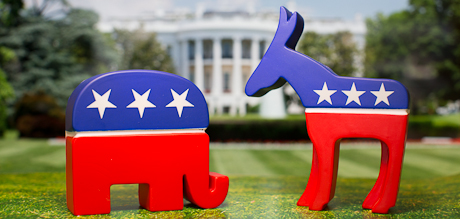With their nominees officially named, the Republican and Democratic parties are now in high gear in the run-up to November’s presidential election.
George Washington University Assistant Professor of Political Science Danny Hayes recently discussed each party’s convention and what voters can expect to hear—and won’t hear—this fall from former Gov. Mitt Romney and President Barack Obama.

A: The nominee’s speech at any convention is usually a highlight, and I think that was true for the Republicans this year. Romney’s address wasn’t surprising or remarkable for its content. After all, the case he laid out against the Obama administration is the same one he’s been making for months—even years! But it’s worth noting that the convention underscored how solid Romney’s support is among GOP delegates and voters. Remember the speculation just a few months ago that Romney wouldn’t be able to “unify” the party? Well, Tampa underscored a truth that is too easily forgotten each presidential election year—the campaign, including the conventions, serves to rally the party behind its nominee, even when a primary fight might be perceived as “bruising” or “divisive.”
Rep. Paul Ryan’s speech was also a highlight. Regardless of what happens this year, Ryan’s emergence onto the national stage signals the rise of a new generation of GOP leaders. He could be just the first of the “young guns” to find themselves speaking for the party in the coming years.
You can’t talk about the RNC without mentioning Clint Eastwood and his chair, of course. When I asked my students last week what they thought the convention’s most memorable moment was, Eastwood won, hands down. That isn’t good for the party. I doubt any viewers changed their mind after seeing Eastwood’s performance, but the news attention the speech received might have detracted a bit from the media-driven bounce in the polls that Romney got.
Q: And what about the DNC?
A: Just like for the Republicans, Obama’s speech—despite being moved to the cozier indoor venue—was probably the biggest moment in Charlotte. I suspect that for many Democrats, seeing the president in his element—on a stage, giving a campaign address—was a reminder of how they were inspired in 2008. And that is certainly what the Obama campaign is hoping. It’s harder to be loved as a president than as a candidate, and the convention might have rekindled a bit of the spark between Democratic voters and their suitor-in-chief.
Michelle Obama’s and Bill Clinton’s speeches seemed to have been well-received. But it’s important not to make too much of those moments. The conventions—and certainly not any single speech—aren’t changing many voters’ minds. For one thing, most of the people paying attention to them are partisans, not independents or undecided voters. But what the DNC likely did was to remind Democrats why they’re Democrats in the first place. And given the importance of rallying the base in an era in which so much of campaign strategy is about voter mobilization, the enthusiasm that the conventions generate in general is worth paying attention to.
I didn’t get the sense that the convention speeches focused on Romney’s time at Bain Capital resonated all that much with the delegates. And they didn’t seem to get much attention from the media, which is the way that most Americans—who are more likely watching the Giants vs. the Cowboys than the proceedings in the convention hall—find out about what happened at the conventions. So that message may not have done much, if anything, for the Obama campaign.
Q: Coming out of the conventions, would you say one party gained more momentum than the other?
A: Momentum is difficult to quantify, but both candidates probably received a boost in the polls. From the analyses I’ve seen, Romney got about bounce of two to three points. Surveys over the weekend hint at a larger convention bump for Obama, but it will take another day or two to determine how big it actually turns out to be.
Q: What were some of the differences in Republicans’ approach to the RNC, and Democrats’ approach to the DNC?
A: The parties approaches were pretty similar—a lot of “red meat” for the party base (GOP attacks on Democrats’ inattention to the deficit, Democratic criticism of the Republicans’ plans to cut social welfare programs), numerous attempts to “humanize” the candidates (Ann Romney telling the story of her and her husband’s early days together, Michelle and the Obama girls appearing on stage with the president) and a bushel of nightly criticism of the other guy.
Q: Moving forward, what are voters going to hear from Romney and Obama heading into November?
A: The conventions were a pretty good preview of what Americans—especially those in Ohio, Florida and other battleground states—will hear over the next eight weeks. Romney and Ryan will continue to emphasize the slow economic recovery and make the case that the Obama administration’s policies are to blame. Obama and Vice President Joe Biden will spend a lot of their time arguing that Republicans would gut the social safety net that many voters rely on. And, critically, both campaigns will be spending a lot of time—far from the media’s eye—attempting to register and mobilize voters in an attempt to win the turnout battle on Election Day.
Q: What won’t we hear?
A: I suspect Romney won’t be doing any more singing before Nov. 6.


